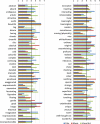Artful terms: A study on aesthetic word usage for visual art versus film and music
- PMID: 23145287
- PMCID: PMC3485829
- DOI: 10.1068/i0511aap
Artful terms: A study on aesthetic word usage for visual art versus film and music
Abstract
Despite the importance of the arts in human life, psychologists still know relatively little about what characterises their experience for the recipient. The current research approaches this problem by studying people's word usage in aesthetics, with a focus on three important art forms: visual art, film, and music. The starting point was a list of 77 words known to be useful to describe aesthetic impressions of visual art (Augustin et al 2012, Acta Psychologica139 187-201). Focusing on ratings of likelihood of use, we examined to what extent word usage in aesthetic descriptions of visual art can be generalised to film and music. The results support the claim of an interplay of generality and specificity in aesthetic word usage. Terms with equal likelihood of use for all art forms included beautiful, wonderful, and terms denoting originality. Importantly, emotion-related words received higher ratings for film and music than for visual art. To our knowledge this is direct evidence that aesthetic experiences of visual art may be less affectively loaded than, for example, experiences of music. The results render important information about aesthetic word usage in the realm of the arts and may serve as a starting point to develop tailored measurement instruments for different art forms.
Keywords: aesthetic impressions; art forms; emotiveness; empirical aesthetics; word usage.
Figures



References
-
- Adachi T. Accurate learning of word usage: Differentiating semantically similar words. Foreign Language Annals. 2003;36:267–278.
-
- Backhaus K. Erichson B. Plinke W. Weiber R. Multivariate Analysemethoden. Eine anwendungsorientierte Einführung [Multivariate methods of analysis: An application-oriented introduction] Heidelberg, Germany: Springer; 2003.
LinkOut - more resources
Full Text Sources

